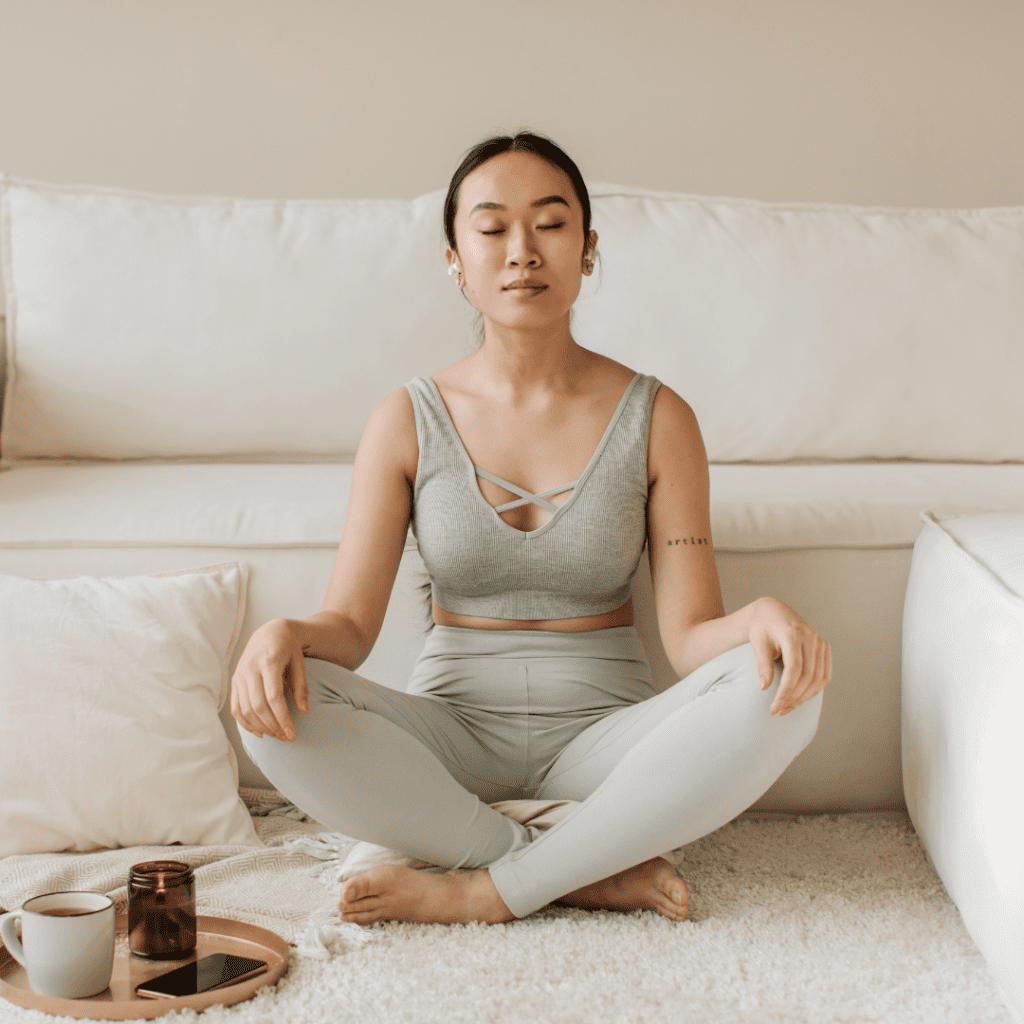Have you ever wondered how to start a self-guided yoga practice at home without going through teacher training, learning special skills, or reading long books on the topic of yoga?
This is a great thing to wonder about! And I believe it is the seed beginning of a fruitful and fulfilling self-practice. But sometimes we need some guidance to begin.
First, let’s talk about some reasons why you might start a home practice.
Maybe you don’t have time to go to the local yoga studio…
Maybe there is no local studio…
Maybe you don’t love the studio schedule or it doesn’t fit with yours…
Or, perhaps you’re looking to deepen your relationship with yourself by meeting your personal needs day by day with an intuitive yoga practice.
All of these are valid reasons to start a self-guided, home yoga practice. And there are countless other reasons, too.
I encourage my students to have and develop a home practice because I see it as the best way to truly understand your practice and what it means to you. In addition, it’s great to be an independent practitioner because you can then take your practice with you wherever you go and no matter what happens. Anyway, yoga was originally practiced in solitude! And while the group dynamic is so juicy and lovely, there’s a special power to uncover in a self-guided practice.
So, let’s talk about how to begin or develop your home practice with tips that you can integrate right away:
Tip #1: Keep it simple!
Maybe you’re going to a group yoga class and the teacher takes you through a vinyasa flow of 10 different poses, one leading into the next, and you have no idea how you might re-create something like that at home.
The good news is, you don’t have to!
Yoga can be super simple. And, I find, it is most effective when it’s simple, direct, and intentional.
Your home practice could look like being in one single pose. It could look like stringing together three yoga poses. It could look like just practicing a sun salutation or a sequence that you already know well.
The best way to go about this is to tune in and ask yourself: what would feel best right now? Let go of any ideas of what a practice should look like, and trust your innate wisdom.
If you’ve been sitting at a desk all day, you’re probably going to enjoy dynamic poses that stretch the back of your legs and spine.
If you’ve been working on your feet all day, you’re probably going to enjoy a seated pose – something to open and relax your hips.
So it all depends.
My best piece of advice is to choose one pose that it is calling to you and just dive into it.
Even if you only do that one single pose for an entire week, by the end of that week you’re not only going to feel amazing about starting a yoga practice on your terms, but you’re also going to understand that pose that you chose in a whole different way — in a deeper way.
This is how we develop our home yoga practice: by simplifying things and taking time to truly understand the poses and practices, one by one.
One of my teachers, David Life, would say that if you understand one yoga pose — if you truly know one yoga pose — then actually, you know them all. So keep it simple.
Tip #2: See your yoga practice as medicine
This point ties in with the first one: taking a medicinal approach to yoga means that you recognize the power of the practice and are intentionally and consciously choosing a pose, or series of poses, that makes the most sense for your present needs.
Yoga is a healing modality. You wouldn’t take medicine to heal you unless you needed that medicine — or the effect of that medicine. Taking medicine that you don’t need isn’t usually a great idea. And I think the same goes for yoga. Developing a home practice means that you have the freedom to meet your needs directly. Now, that being said, although yoga is a healing modality, it’s not meant to fix you, because there’s nothing wrong with you. Healing and fixing are two very different things. Yoga is a practice that is meant to get to know you, or who you are. And it’s that relationship with yourself that ultimately heals us.
And so taking a medicinal approach to yoga — where you are intentional and conscious about what you choose — means that you are slowly, over time, getting to know yourself in a whole new way. You’re getting to know your body, and your unique needs, and maybe starting to notice some patterns. For example, you might notice how your yoga practice changes through different seasons, based on what you do that day or based on where you are in your menstrual cycle. These are all great patterns to notice and inquire into, as opposed to taking a frivolous and fancy approach, where we are practicing for the sake of what it looks like. This is the beauty of home practice: when you remove all of the temptations to compete or to showcase your practice to other people, then you can get honest and real and raw with yourself. This is when the real magic happens.
There have been days when my yoga practice just looked like laying in savasana, crying and rubbing my belly. Honestly, yoga is you. And it depends on how and who you are.
Tip #3: Get yourself a prop or two
Now, what sort of yoga props you invest in really depends on your needs. But in most cases, having a yoga block and a yoga mat is a great place to start for your home practice.
A yoga mat is going to allow you to create a yoga space in any room that you are in, and a yoga block is versatile. You can use a yoga block in a full range of practices from meditation, to restorative, to your more fast-paced, dynamic practices. Having a yoga block is kind of like having a teacher or assistant with you at home. It’s something you can lean on for support, and it’s going to give you great feedback in your practice. You can use blocks to bring the earth closer to you or to support your body in more restorative practices. So get yourself a nice yoga block.
I recommend cork blocks because they’re super steady and stable, and if you want a little extra cushioning you can always throw a blanket on top of it.
Something else I always have handy when practicing at home is a firm and thick pillow. I love using a pillow under my knees in savasana, and if I’m doing a more restorative practice where I’m supporting my body, I always make sure I have a pillow nearby. Your pillow prop is free, as you probably already have one, so that’s a great place to start.
Tip #4: Set the space
Now, you want to think of the space that you choose as part of your ‘propping,’ because the space that you choose will set a tone for your practice. For example, if you practice in the middle of your family room where someone is watching the TV, someone else is cooking dinner, and someone else is running around or wanting to talk to you, then you’re going to have a much different practice than if you can close a door and remove distractions.
Most times, a yoga practice happens in a loud and messy life. So this point is not about seeking perfection. But whenever possible, do try to create a soft boundary around your practice so that you can set aside even just 5 min just for you to tune in with yourself.
If this is not possible, then know that you can always tune into your breath no matter where you are or what you’re doing, and that is a complete yoga practice.
If you can create a quiet and serene practice space, it’s a good idea to play some music, dim the lights, and create a studio-like feel. This is conducive to your self-reflection and will support you in tuning in – feeling into your body and what is needed. And this takes me to my fifth and final point…
Tip #5: Let your body lead the way
So many things in life require our mental abilities, and so we are conditioned and very familiar with using our minds to plan or figure something out. The mind is an amazing tool for these purposes, but it doesn’t have as much power as you might ‘think’ in the yoga practice. Physical yoga practice is a body-and-mind practice. This takes me back to my first suggestion which is just to choose a pose that feels good for your body. And, chances are, if you can drop into that one pose, your body will then naturally lead you into the next one. And what is good for the body is also good for the mind. So, the thinking mind relaxes in your yoga practice and gives more room for the body’s intuitive ‘voice.’
This goes against our cultural grain, which is a good thing. Learning to be more body-centered is part of the reason why yoga has such a calming and grounding effect, as it reforms the mind-body connection and restores our sense of wholeness. This means that the mind is not leading the way, but that the mind and body are in sync and working together in a mutually beneficial relationship.
_
I hope you enjoyed the 5 tips in this article! If it’s been helpful for you, share it with someone who you think would love to read about starting a self-guided practice.
If you’re looking for further guidance and inspiration to begin your home yoga practice, check out our YouTube channel!
Thanks for reading, and happy practicing.
Love,
Jaylyn
Women’s Yoga Therapist



